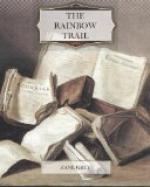“Try it,” he said to Shefford, with his lazy smile. “See if you can heave it.”
Shefford was strong, and there had been a time when he took pride in his strength. Something in Joe’s supreme effort and in the gloom of the Indian’s eyes made Shefford curious about this stone. He bent over and grasped it as Joe had done. He braced himself and lifted with all his power, until a red blur obscured his sight and shooting stars seemed to explode in his head. But he could not even stir the stone.
“Shefford, maybe you’ll be able to heft it some day,” observed Joe. Then he pointed to the stone and addressed Nas Ta Bega.
The Indian shook his head and spoke for a moment.
“This is the Isende Aha of the Navajos,” explained Joe. “The young braves are always trying to carry this stone. As soon as one of them can carry it he is a man. He who carries it farthest is the biggest man. And just so soon as any Indian can no longer lift it he is old. Nas Ta Bega says the stone has been carried two miles in his lifetime. His own father carried it the length of six steps.”
“Well! It’s plain to me that I am not a man,” said Shefford, “or else I am old.”
Joe Lake drawled his lazy laugh and, mounting, rode up the trail. But Shefford lingered beside the Indian.
“Bi Nai,” said Nas Ta Bega, “I am a chief of my tribe, but I have never been a man. I never lifted that stone. See what the pale-face education has done for the Indian!”
The Navajo’s bitterness made Shefford thoughtful. Could greater injury be done to man than this—to rob him of his heritage of strength?
Joe drove the bobbing pack-train of burros into the cedars where the smoke of the hogans curled upward, and soon the whistling of mustangs, the barking of dogs, the bleating of sheep, told of his reception. And presently Shefford was in the midst of an animated scene. Great, woolly, fierce dogs, like wolves, ran out to meet the visitors. Sheep and goats were everywhere, and little lambs scarcely able to walk, with others frisky and frolicsome. There were pure-white lambs, and some that appeared to be painted, and some so beautiful with their fleecy white all except black faces or ears or tails or feet. They ran right under Nack-yal’s legs and bumped against Shefford, and kept bleating their thin-piped welcome. Under the cedars surrounding the several hogans were mustangs that took Shefford’s eye. He saw an iron-gray with white mane and tail sweeping to the ground; and a fiery black, wilder than any other beast he had ever seen; and a pinto as wonderfully painted as the little lambs; and, most striking of all, a pure, cream-colored mustang with grace and fine lines and beautiful mane and tail, and, strange to see, eyes as blue as azure. This albino mustang came right up to Shefford, an action in singular contrast with that of the others, and showed a tame and friendly spirit toward him and Nack-yal. Indeed, Shefford had reason to feel ashamed of Nack-yal’s temper or jealousy.




